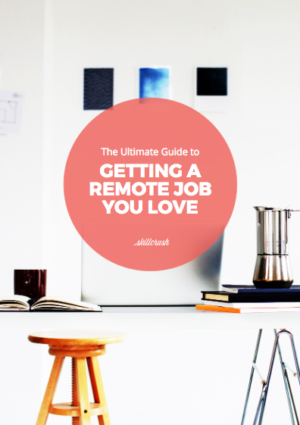
Get Our FREE Guide to Landing a Remote Job You Love
Say goodbye to the 9-to-5. Learn the steps you can take TODAY to get a remote job.
You’re getting antsy at your job, so you’ve started freshening up your resume, organizing your portfolio, and scrolling through job listings. . . and you land on an opening at your dream company. Scanning the list of requirements, you see that you meet most—but not all—of the items. Should you apply?
The question of how many eligibility requirements are necessary when applying for a job is especially important for women. A now-ubiquitous Hewlett Packard report of personnel records shows that women at HP applied for a promotion only when they met 100 percent of the job’s listed qualifications, whereas men applied when they believed they met 60 percent.
The Harvard Business Review’s Tara Sophia Mohr dug into this idea in more depth in a 2014 article, and she deduced that the issue is not women inaccurately sizing up their skill sets—if you think you only meet 50 percent of the qualifications, you probably only meet 50 percent of the qualifications—but a miscalculation of the weight of not measuring up. “This is critical,” she writes, “because it suggests that if the HP finding speaks to a larger trend, women don’t need to try and find that elusive quality, ‘confidence,’ they just need better information about how hiring processes really work.” (Although, women finding some more confidence would be nice, too.)
So what is the reality of the hiring process? How many qualifications does an applicant really need to have in order to land the job?
For starters, let’s dispel the myth that you have to meet the 100 percent so many women are holding out for. Laura Palmer, a tech industry recruiter, says “people absolutely do not have to meet every requirement on a job posting. Oftentimes, a job posting represents an ideal candidate, and a realistic candidate could be bringing in, for example, less years of experience in one bulleted requirement, but other skills that would be beneficial and potentially not even listed online.”
Among the most flexible requirements are college degrees and years of work experience. Tes Akhtar, HR consultant for computer programming and website design company Potent Pages, says that you don’t need an advanced computer science degree or even a bachelor’s degree to get a tech job—you simply have to show your prospective employer you can do the work. And when it comes to how long you’ve been on the job, Valerie Steif, senior content manager for Pramp, a platform for software engineers to practice coding interviews online, suggests a qualitative, not quantitative approach. Ask yourself: “Do they want five years of experience and you only have three? Were those three years of experience that you have packed full of intense projects and other learning opportunities or were you passively ‘just getting by’ at your job?” she says. If your less-than-listed amount of experience was overflowing with learning and production, you probably have the experience.
When you’re looking at a job listing, pay attention to the order of the qualifications—it’ll likely tell you what’s most important to the employer. As a rule of thumb, Palmer suggests that an application should meet 80 percent or more of the first five requirements, and 60-70 percent of any additional requirements.
These requirements are especially flexible in tech, where a solid portfolio goes farther than a resume. “Remember that most tech companies are looking for someone who can do a job and complete work, not necessarily meet a set of criteria. . . In tech, it’s all about results,” Akhtar says.
While requirements like a college degree or years of experience are somewhat malleable, some items on a prospective employer’s wishlist are necessary, Akhtar says, pointing to a specific programming language or the ability to work with a set of technologies, like Git. While you can certainly learn some things on the job, an applicant for a Front-End Developer job, for example, must know HTML, CSS, and JavaScript, etc.
If your resume is on the thin side, a well-written cover letter can round you out as a candidate and be the tipping point for a hiring manager. Instead of trying to explain away your gaps, Palmer urges that you demonstrate how the experience you do have makes you the perfect fit—even without meeting every single requirement. So instead of saying “I don’t have X skill,” Palmer suggests: “My experience executing on ABC would position me for success in this way. . .” Since “a candidate has no idea what a hiring team is truly prioritizing as a must-have for the role (even if it’s labeled as such in the job description!). . . the sell is still ‘I’m the right person for the role. Here’s why, from my background and experience,’” Palmer says. Hiring managers might not even notice you don’t tick all the boxes on their job listing.
The takeaway? Being the “right fit” for a job is about so much more than your resume showing all the criteria posted in a listing. Polish that portfolio, pay special attention to the open position, and apply. You got this.

Get Our FREE Guide to Landing a Remote Job You Love
Say goodbye to the 9-to-5. Learn the steps you can take TODAY to get a remote job.

